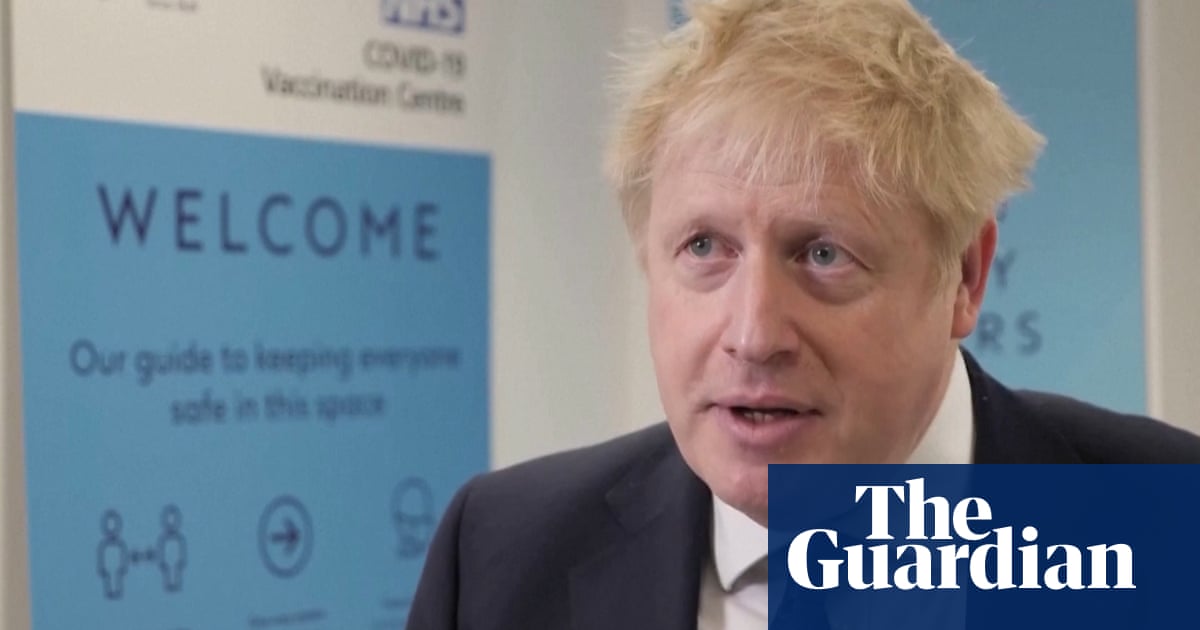
Boris Johnson has said the government is “looking at the science” of moving to an isolation period of five days in England instead of seven for a positive Covid case, after calls to ease staffing shortages across the economy.
The prime minister confirmed the government was examining the proposal, after several cabinet colleagues made clear they would like to see a shift to five-day isolation if possible.
Asked about the issue on a visit to a vaccine clinic at a pharmacy in his Uxbridge constituency, Johnson said: “The thing to do is to look at the science. We are looking at that and we will act according to the science.”
The debate arose after the US shifted its isolation requirements to five days after a positive test. The situation in the UK is different, as isolation in symptomatic cases begins from the start of symptoms rather than a test, but some senior Tories are pressing for a cut from seven to five days in asymptomatic cases at least, where isolation begins from the point of a positive test.
The government has sounded a cautious note until now, since it only recently cut isolation requirements from 10 days to seven days for asymptomatic cases if a person tests negative by lateral flow on days five and six of isolation.
However, the education secretary, Nadhim Zahawi, broke ranks to say on Sunday that a move to five-day isolation would be “helpful” if it were supported by the evidence. The Telegraph reported that Rishi Sunak, the chancellor, takes a similar position.
Speaking on his visit to the vaccine centre, the prime minister also pledged that free lateral flow tests would be available for “as long as it is necessary” after reports over the weekend that individuals and businesses would soon have to pay for them.
Johnson’s official spokesperson also stressed that free lateral flows would stay for the time being.
“There’s absolutely no plans to change that,” he said. “We will use testing as long as necessary. It’s a vital line of defence alongside our vaccine programme. With cases high across the country there’s no doubt that the use of lateral flow devices are both disrupting chains of transmission and saving lives. We’ve got 425m tests coming in January, as we’ve set out.
“Those of you who read through the autumn and winter plan will know that we set out then that at a later stage, as the government’s response to the virus changes, universal free provision of these tests will end. I think that’s what the public would expect.”
He also said it was too early to say whether the UK was in the process of moving from a pandemic stage of Covid to an endemic stage, after Zahawi suggested the UK should show the rest of the world how to get back to normal.
Michael Gove, the levelling up secretary, set out a similar view in his broadcast interviews on Monday morning, as he said the country was moving to a stage where it could “live with Covid”.
Having previously argued for caution around Omicron, the senior cabinet minister said the easing of restrictions would have to be guided by science, but “the sooner the better”.
He told Sky News: “We are moving to a situation, we’re not there yet, but we are moving to a situation where it is possible to say that we can live with Covid, and that the pressure on the NHS and on vital public services is abating.”
The UK Health Security Agency estimates that 10-30% of people who self-isolate after a positive Covid test are still infectious on day six, dropping to about 5% after day 10. Their modelling suggests a similar risk of being infectious – about 5% – if people end isolation after two negative tests on days six and seven. The work underpins the existing guidance on Covid isolation, but the thinking may change as more data come in on Omicron.
Preliminary findings from Japan’s National Institute of Infectious Diseases hint that people who have asymptomatic Omicron infections may stop shedding the virus sooner than those who have symptoms. This is not unexpected, but the study includes only 21 cases, so the results are considered tentative.
The researchers took 83 respiratory specimens from 21 people infected with Omicron. Only two of the people were unvaccinated and four had no symptoms. Tests showed that people shed most virus three to six days after either diagnosis or the onset of symptoms, with the amount falling gradually from then on.
While those with Covid symptoms harboured infectious virus until day 10, the researchers did not obtain any infectious virus from the four asymptomatic people beyond day five. The scientists are cautious about the results, concluding only that vaccinated people with Omicron are unlikely to shed infectious virus 10 days after diagnosis or the onset of symptoms.
Source: Guardian







